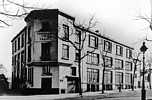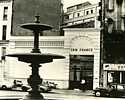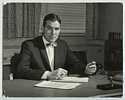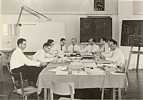Oral History 5.0 megabytes .pdf
Hi Robert,
The 1401 has been such a major event in my IBM life that I have too many
recollections including pictures.. and I don't know where to start!
Unlike Karl, I don't have the time or the motivation to embark in the
task of writing books about it!
Let me try for a beginning to share some elements for thoughts
- The initial project, and the resulting competition between the 3 IBM
labs came from a visit of the IBM France President Christian de Waldner
to Watson complaining about the major inroads that the French computer
company Bull was doing to IBM, mainly in tne banking areas for lack of
IBM answers.. The competition decision was then taken at the highest IBM
level.
- I do have, but so do you certainly, many 1401 and 1400 related
patents bearing my name
- Back in 2002, there was a lot of Email exchanges coordinated by Van
Snyder <vsnyder AT math DOT jpl DOT nasa DOT gov> on the subject of 1401 and
"1401 nostalgia". If you have not already done so, you may
contact him
- Many years ago (I was still active with IBM) I was asked to audio
record my recollection of the 1401 history for an IBM "Oral history
program". I am sure this should be readily accessible for you
- Concerning the "plug board approach" of the WWAM (which
incidentally was also referred to at its beginning as VLAM: Variable Word
Length Accounting Machine) we started with a stored memory program but
found out that we could not afford the cost of memory at the beginning of
the project. This is why we reverted to a plug board approach, trying to
make it as compatible as possible with the stored program approach...
until the cost of memory went down and the US team was able to
considerably improve the project by going to a stored program...
- The WWAM wanted also to "prove" a new packaging "card
on card" approach. The initial WWAM model was built this way, and I
have of course numerous pictures of this design and the implementation
team.
- 1401 was such a commercial success that IBM managed to have its
private jet registered under the 1401 name. Among my many "old"
pictures I have one of the jet landed in the Nice Airport, showing
its registration name and the official visit (including Tod Groo IBM VP
at the time)
- Among the WWAM team which worked in Poughkeepsie, the "chief
product planner" was Jacques Maisonrouge well known who later became
President of IBM Europe and Vice-President of IBM Corp
- Thre are still a number of engineers and techniciens who participated
in the design and build up of the initial WWAM in the IBM La Gaude
laboratory, still alive in the area.
- The intial WWAM model has been used in the La Gaude Laboratory for
quite some time as part of the computing center. There was even a project
to move it to the USA for patent purposes... We tried to preserve it...
but I don't know what was its final fate
We will probably have some more exchanges in the future.. but I hope
that the above may help as a beginning.
Best regards
At 07:25 26/03/08, Robert Garner wrote:
Bonjour Maurice,
I've learned through exchanging emails with Karl Ganzhorn about your
involvement in the mid 1950's in IBM's WWAM task force.
I am working with a group of volunteers at the Computer History Museum in
Mountain View restoring an IBM 1401 to complete operation.
May I ask if you might be interested or able to in share any of your
stories, recollections or history of the WWAM / 1401 project?
Regards,
- Robert
p.s. I'm also trying to locate Francis Underwood, principle
designer of the 1401 in Endicott.
And Ralph Mork, or any other surviving members of the WWAM / 1401 team.
Maurice Papo
IEEE
Past Vice President Regional Activities
2001-2005
14, Bd Prince de Galles
06000 Nice, France
Email: m.papo DOT ieee DOT org
Phone: (33) 493.81.41.12
Fax: (33) 493.53.26.73
-------------------------
|
A collection of e-mails working to find answers
From Gary Mikotoff 4/4/2008
| We have contacted Jack Palmer. His e-mail address is Jack Palmer
[jackpalm AT Charter DOT net]. Part of the e-mail he sent Dave Macklin and me
stated:
"But (1) his name was Francis O. Underwood, and I seem to recall that others
have tried to find him in recent years, unsuccessfully. And (2) don't
hesitate to communicate with me, particularly concerning am apparent 1401
COBOL inquiry. And (3) I remember an engineer Glen Nielsen in San Jose, I
think a manager, I think on the 1620 project, no 1401 connection that I ever
heard of. And (4) I remember Gary sending the 1403 in the T/L basement into
a paper-consuming paroxysm, via a no-escape null print loop that had it
executing endless skip-to-top-of page instructions. And (5), tying into
Gary's story, I remember that the first index register arithmetic did not
wrap around, making it impossible to decrement IR contents. They quickly
redesigned it on our recommendation to wrap around at 16K, but, as always,
it took forever to get our own machine fixed.
And finally, Dave, Gary's memory seems to be better than yours (and why
not?!), for you have slightly garbled the history thing via capitalization
and lack of mention of co-authors, etc., but you get credit for coming up
with my e-mail address!
With best regards,
Jack
|
Q from Robert Garner, Answer by Maurice Papo 4/5/2008
I'm getting the impression that the 1401 was marketed fairly
seriously across Europe..
(I'll forward pic of 1401 "datamobile" in Denmark and 1401 truck
unloading in Finland.)
YES but not only in Europe. The 1401 sales World Wide (!) including the US
were more than any other IBM computer until the PC came along! I kept the
sales figures for a while, and don't remember throwing them away... but god
knows where they are! Along the years, I met many 1401 customers who
remembered it with nostalgia.. Remember that the project started initially
from tough competition by Bull Company which operated only in Europe, but
it quickly found its market value in the US.
|
From an e-mail Garner to Branscomb dated July 16, 2013
|
Chuck,
Thanks for your gracious response to my questions (copied below).
This better explains the relationship between Dayger's tape-to-print project, SPACE, and your involvement!
|
> Things came together as I recall in the late spring of 1959 when I was satisfied and we had some big �guns�
like Bob Evans demanding tape be included with the initial announcement.
|
I assume Bo was demanding tape attach in order that SPACE could be used as an I/O spooler for the 7000 series mainframes?*
Or was he presaging that tape would increase SPACE sales?
According to Shel, no-one realized that was going to happen; i.e., it was a surprise that so many customers
(eventually over 50%) bought tape systems.
|
> We set a rather aggressive schedule considering the fact that almost everything in the system was new.
|
Besides the 1403, which items did you consider new?
From my perspective,
-the Germanium transistors and CDTL circuits were proven from the 7070,
-and SPACE's data paths were taken from the WWAM.
-Also, the tape controller circuits were borrowed from the 7070.
-(The magnetic core memory transformer X/Y driver was relatively new.)
|
> Regarding your question about recording a brief piece on the 1401 goals and the overall Space program, I would be receptive if you feel it would be helpful.
|
That would be great! I'll be meeting with Shel and the woman responsible for the movie script, Jas, next Weds.
I'll get back to you.
- Robert
|
* Perusing a recent issue of the 1964 ACM Proceedings, a practical article, "The STL Integrated Computer Operating System" by TRW, pointed out that their average 7090 compute job took only 3.6 minutes (with 80% completed under 5 minutes), but then each job required an average 4.1 hours on their peripheral 1401s for tape-to-print and tape-to-card, due to the operator sequentially mounting tapes, etc.. (Their configuration was actually two 7090s and six 1401s.) By incorporating a 1301 disk with a custom OS using "job information blocks" to act as a I/O spooler buffer, the overall job throughput dropped to just 1.6 hours, which effectively could allow for one fewer 7094 (if the load remained constant)! Illustrates the importance of balancing computer and I/O, particularly during that era when CPU cycles were so damn expensive. I'm sure this is one reason that Fred insisted that all mid- to high-end 360s have a disk!
|
|
The following enclosed item may be Branscomb to Garner, dated ?
|
Sorry I overlooked responding to your question about goals for the 1401 program. Actually, I think you have a good
understanding of our major goals and later I will comment on why I think Jonie Dayger called our goals �lofty�.
Stated simply, our goal was to move the thousands of �plugboard� (control panel) controlled customers to stored program control. To do that we had to focus upon several major areas:
FUNCTION/COST: For the larger customers, we wanted to make sure we could handle essentially all the applications that a customer with multiple accounting machines and a 604 could run. At the same time, we knew that entry price for the smaller customers was crucial so we established cost targets that would provide a complete small system for less than $2500/month. We were determined to meet this system target - not because it was necessary to have a successful product but because we wanted to move the maximum number of customers to stored program control.
SIMPLICITY: We realized that just function and cost would not move all those customers to a new totally different system. So we did whatever we could to make the 1401 a system people from the old system environment could relate to. Most early computers were �fixed word�. �Variable field length� in our system helped unit record people relate to it and very importantly gave us much more efficient use of memory which was crucial to making our cost targets. Our architecture also provided a very simple, easily understood instruction set.
PRINTING: This was and is a very important function in business data processing. �Lines per minute� always draws a lot of focus but print editing is also an important function and the 1401 was excellent here as well. The 1403 had excellent paper handling which significantly improve throughput in printing applications.
SCHEDULE: We set a rather aggressive schedule considering the fact that almost everything in the system was new.
TAPE TO PRINT: Jonie Dayger had a �tape to print� product under development when the 1401 was begun. Since there were only several hundred potential customers, his forecast was relatively small. This meant that his target rentals were quite high but that was not a problem in the tape to print market. Since we were pursuing large volumes, our target rentals were much more attractive. As a matter of fact, my recollection is that a tape to print version of the 1401 had a rental target lower than Jonie�s product even though it provided much more function. I think this is one reason for Jonie�s �lofty goals� comments. I think the other reason is that there had been several attempts to develop a new system to replace the IBM 402/405/407 and all had failed. The Transcriber (my first assignment in IBM) effort was terminated in about 1953. The MAC proposed out of Poky identified their low end machine and gave very little detail but did note that it would probably be a control panel machine since they could not afford stored program. I think at one point there was proposed a TAM (Transistorized Accounting Machine) but never really got off the ground. And of course the WWAM program was in great difficulty and was terminated with the acceptance of the 1401 into the product plan. So Jonie had some basis for his view and there were others skeptical that we could meet our objectives.
Even though Fran Underwood had architected attachment of tape and disks to the 1401, I refused to incorporate tape into the initial announcement until satisfied that we were going to meet our fundamental objectives. Things came together as I recall in the late spring of 1959 when I was satisfied and we had some big �guns� like Bob Evans demanding tape be included with the initial announcement.
I had a chuckle from your comment about �adopting or stealing� the 1403. Jonie very much wanted the big volume for the 1403 that would come from the 1401 but he wanted more urgently to get his printer into the market and he had a product that would do it. I felt he and I pretty much saw things in the same manner. I did not want to get diverted to tape prematurely and he did not want to get diverted from his product prematurely. By the way, I�m quite sure that Delco developed and made a special high voltage print magnet driver for the 1403.
|
From: Robert Garner to Charles Branscomb, June 16, 2013
From: Robert Garner
Subject: Re: Jonie's tape-to-print vs. 1401 and a new 1401 movie (was Re: IBM Corp Market Research's "67 Years of Progress" chart, 1960, missing the 1401 !
Date: June 16, 2013 11:48:05 AM PDT
To: Charles Branscomb
Cc: ...
Chuck,
Good to hear from you, as always!
>> But Jonie was not convinced that we would meet what he called our "lofty" goals and he continued his product until the spring or summer of 1959.
My understanding had been that you had convinced Jonie to drop his standalone tape-to-print product, thereby deferring the tape-to-print market to SPACE. If he had been comfortable splitting the market (or perhaps he wasn't, and you outright "stole"/adopted the 1403 from him), he clearly must not have been convinced that SPACE was going to be successful. (Another indicator that you, Fran, and Shel were spot on in your predictions of how successful SPACE would be!)
Do you recall your "lofty" goals for SPACE?
>> But Jonie was not convinced that we would meet what he called our "lofty" goals and he continued his product until the spring or summer of 1959.
Do you recall what finally swayed him (or someone ordered him) to drop his tape-to-print machine in the "spring or summer of 1959".
Did his machine use the same high-power hammer driver transistors from Delco? (I assume he didn't get the transistor waver either.)
I understand that Delco had developed them (or perhaps the high-voltage tolerance) for electronic automotive spark plug distributors.
Do you recall if they make a special power transistor tailored for the 1403?
Best Wishes and Happy Father's Day!
- Robert
|
On Jun 16, 2013, at 10:41 AM, Charles Branscomb wrote:
>> Shel
>>
>> My recollection is that we did announce Model D for those customers that only wanted "tape to print"
but I do not know how many were ordered without the 1402.
>>
>> Also, our recollections are a little different about Jonie Dayger's program for a tape to print product.
When his team initially could not find a solid state driver for the print magnet drivers, we joined them in
appealing to Ralph Palmer (director of engineering for our division) for an exception to the edict. Ralph refused and then we joined Jonie's team in pursuing an
outside vendor solution which fortunately was successful. But Jonie was not convinced that we would meet what he called our "lofty" goals
and he continued his product until the spring or summer of 1959. It is unfortunate that Fred Demer (main inventor of the 1403 printing concept)
and Jonie did not receive more recognition for a product that was a profound advance in computer output printing.
>>
>> Chuck
|
On Jul 21, 2013, at 1:31 PM, Charles Branscomb wrote to Robert Garner
|
Robert
The IEEE article is an excellent, informative, articulation of the early computers. Congratulations.
Im sure that Bob Evans push for tape with the initial 1401 announcement was to help the 7000 series. More specifically, the 7070 was in real trouble and Bob was moved up to Endicott to bail it out.
My thoughts on what was new in the 1401 program may be somewhat different from yours. My thinking starts with the people in Engineering, Manufacturing, and Field Service and their lack of experience in dealing with anything like the 1401. My guess is that three fourths of them had never been exposed to a stored program system, solid state technology, and the packaging, power supplies, cabling, etc. that support low level signals. The projected production volumes of the 1401 presented a severe training challenge in manufacturing and field service. The lack of experience showed itself in many ways. For example, we had great debates with manufacturing about product costs and with field people about service costs. Both of these had real effect on meeting our rental targets and frankly, we never did get what we thought were proper service estimates because of their inexperience with something like the 1401.
Back to engineering and people. Start with me - I had taken 2 or 3 night school electronic courses but I had zero experience in stored programming and solid state technology. Most of our logic designers had some tube circuit experience but not solid state. Also, we of course had essentially no design automation in those days to help identify timing races, hot spots, etc. In view of our focus on cost and our volume, we worked with the circuit designers on special SMS cards rather than just use the standard cards. I wish I could recall the specifics about power supplies, for example. I feel quite sure that we were not satisfied with the "standard" supplies and pursued supplies specific to us that were more reliable and cost effective. It is clear some of the internal data paths were from WWAM but I think you would find the input/output was handled quite differently and of course variable field length was handled with word marks. Further, implementation of the data paths in the most reliable and efficient manner was much more crucial to me. By ther way, I thought I was told by the memory people that the way they were able to meet our cost objectives was with new X/Y drivers.
I will not continue to "ramble" but will mention just one other example. It was the very early days of back panel wiring with Gardner-Denver machines and this was a real concern for some of us. To make changes in the field, service people had to use a manual tool and that led to some troubles.
Its difficult to put myself back into the second half of the 50's but I'm comfortable in saying that almost everything in the system was new to a large percerntage of the people who had to design, manufacture and service the 1401.
Regarding tape on the 1401 itself, we certainly did not focus upon a tape processing system. We did know that the 1401 was excellent at card to tape and tape to print functions. I am still not convinced that the 1401(not the 1460,1410, or 7010) with no operating system was an adequate tape processing system. My guess still is that most 1401's with tape were used for I/O operations but of course I do not have any data to support that view.
Chuck
|
|
Two IBM 1401 Principle Founders found!!
from Robert Garner, April 16, 2008
|
Folks,
I have some auspicious news to report: After several years of on/off searching, I've located the 1401's lead designer and "father", Mr. Francis O Underwood! He's living in Lockhart, TX. In addition, at Fran's urging, I soon found the 1401's lead marketing/planner, Sheldon Jacobs. He's closer, in Saratoga, CA. Both are now on our 1401_team alias and are cc'd on this email.
Fran is just delighted that we're interested in the seminal 1401, have restored one for the Museum/public and considers it an honor to be able to help us out. He has delightful, insightful stories to tell, and hopefully we'll get him on the phone soon. (btw, He also worked on the 1130 and 1800.) Shel is also quite excited about our project and is looking forward to participating and sharing his many period stories.
I've also been in email contact with two original members of IBM's World Wide Accounting Machine (WWAM) program that preceded the 1401/SPACE program: Maurice Papo (in Nice, France) and Karl Ganzhorn (in Germany), also cc'd on this email. (They went on to lead IBM's respective research labs in Europe.) Maurice has shared several fascinating 1401 pictures, including the "1401 plane" and a wooden model of a 1401 system (given to him by his staff): http://ed-thelen.org/1401Project/OutsidePhotos.html
All four are just delighted that we have so much interest in the 1401 and are honored to be associated with our restoration project. Fran and Shel are brimming over with 1401-era stories to share. What follows is my synopsis of some Shel shared on Thursday on the phone, and some from my correspondence with Fran. (Which we'll eventually record/put on site. See this link for some fascinating/incredible Fran narratives: http://www.ed-thelen.org/comp-hist/stories.html#Fran
First, from reading the oral histories and discussions with Fran & Shel, I've come to understand why 1401 sales literally exploded and also learned something new - that Fran & Shel had to overcome some significant early doubts about the viability of the 1401 in the business marketplace.
Although we take stored program computers for granted, several "status quo" factors were obscuring potential progress in the market: 1) the predominance of feature-ladened plug-board accounting machines, 2) certain Endicott planners not understanding the power of combining computing and card handling into one machine, and 3) little appreciation of the resulting software ecosystem waiting to be created.
It took Fran's vision of the suitability of a stored-program architecture for the high-volume, business market (and a particular circuit designer reducing the cost of core and other fortuitous events from engineering, e.g., SMS, chain printer, and 088) and Shel's doggedness to get his 1401 volume estimates (validated by his customer visits) accepted by Endicott planners that finally got the 1401 across its chasm. These factors all converged at the same time as a glaring market vacuum/black hole for an inexpensive stored-program machine had opened up. The 1401 just sweep away the unit-record accounting market. It was the market's first high-volume, stored-program computer.
This account from Fran is stirring:
About a week before the product announcement of the 1401
Tom Watson actually came to my office seeking some
confirmation about the current sales forecast. I could see
that he was finding it difficult to believe the 3500 unit
projection. I told him that not only was it true, but we actually
expected far more sales; at least 10000. I could see his eyes sparkle
with the thought of so much revenue.
|
There was just an enormous market demand for the 1401: According to Shel, IBM sales booked the entire five-year 1401 planning forecast--5,100 systems--in the first five WEEKS! Fran mentioned in his 1968 oral history that they booked 750 systems alone in the first week alone. Shel said that the eventual run rate for the 1401 was $30 million per month. If that happened in say 1966, in today's 6.5x inflated dollars that would be equivalent to $200 million per month!
My interpretation: If one assumes that a typical 1401 system rented for say $3,000 a month (Shel?), using a ratio of about 50x between monthly rental and purchase cost,* and 6.5x to get today's dollars (that's a 325x combined multiplier!), those 5,100 systems, if purchased, would have been come to $5 billion worth of sales in today's dollars! That's one billion a week for a complex computing system. (Of course, IBM likely earned more renting.)
The 1401 was so successful for IBM that Fran wrote that five key deserving members (and spouses) of the team were later granted three-week, first-class, fully-paid vacations to anywhere in the world! (Don't get any ideas! ;-)
Regarding the 1401 name, Shel said that the 1401 was NOT named after is minimum memory size, 1400 characters. Apparently IBM marketing had decided to grow to 4-digit names and "1401" was the first 4-digit designation, arbitrarily chosen. Shel had originally suggested the "450" (perhaps a merge of 400-series tabulators, 403/407, and the 650, since many saw the 1401 as a follow-on to the 407/650/604 market. Shel? Of course, Fran's internal project name, SPACE, (Sputnik-inspired) would have better, as sales rocketed there. ;-) I believe Shel said 15,000 total 1401's were sold. (Shel?)
More on 1400 characters: Fran hand-coded the "French banking application" in 1400 characters. (It was known as "le plus grand decouvert", handled well by the existing Bull Gamma III that was outselling IBM accounting machines in Europe, according to Maurice). Shel also had a sharp young engineer code up in 1400 characters an inventory/billing/commission application for a NJ correspondence school. Nevertheless, Shel noted that "almost no" 1,400-character machines were sold, as we've understood. 1400 characters seemed to be a demonstration that the pricing-sheet, entry-level $2,500/month config could handle any unit-record/accounting job, and cheaper.
More to come...
- Robert
p.s. I also have copies of early 1401 and WWAM design documents and oral history transcriptions taken in the late 60's (thanks to the IBM archivists, Paul Lasewicz and Dawn Stafford.)
* Here's where I saw the rental vs. purchase cost figures from for the 1401:
http://ed-thelen.org/comp-hist/BRL61-ibm1401.html
COST, PRICE AND RENTAL RATES
Manufacturer Monthly
Basic System Cost Rental
IBM 1401 Processing Unit, $ 70,500 $1,200
Model A-1
IBM 1402 Card Read Punch, Model 1 24,800 550
IBM 1403 Printer, Model 1 30,300 725
Total $125,600 $2,475
Additional Equipment
IBM 729 II Magnetic Tape unit $ 27,500 $ 700
IBM 729 IV Magnetic Tape Unit 59,000 1,100
(maximum of 6 tape units)
Tape Input-Output Adapter Feature 22,700 980
IBM 1406 (Additional Core) Stor- 20,100 to 575 to
age (3 models) 55,100 1,575
Maintenance contracts available for purchased or rented
equipment.
Which also indicates delivery time was 2 years!
inflation calculator: http://www.westegg.com/inflation/
|
WWAM Photos from MauricePapo - April 23, 2008 & Dec 19,2014
- After announcement:
- Status Symbol
|
I was just reading Karl Ganzhorn's History-02 email to you and something jogged my memory.
While the initial cost objectives could not fully be achieved the 1401 nevertheless found a huge market, admittedly not for the
originally aimed smaller customers for which Jonny Dayger's 1403 printer was too powerful and expensive, but the only one available.
This was solved with the follow-on systems IBM 1430, IBM /360 Model 20 and /360 Model 15 later.
After the first few systems were installed in Atlanta having a 1401 system turned into a "Status Symbol". Customers were building
show place computer rooms with plate glass windows to view system from the hall. Some even had a button you could push and hear a
recording describing the system. I remember two really nice ones at Avon (the Cosmetic company) and Retail Credit Corp. (later to
become Equifax). This was before the race riots in Los Angeles(1) where a data center was burned down and the insurance companies
demanded much more security. Before that you could just walk in off the street to any company and go where you wanted. There
may be a receptionist in the lobby but no security guard and sign in desk.
These show case computer rooms reminded me of things that came later like, my lawn mower is bigger than yours, and still later
my SUV can crush your Minivan. Everyone wanted one and some companies jumped the gap and were paying more for their 1401
than they did for their EAM installation. We ended up with 125 1401 systems in the Atlanta metro area.
Van Gardner
|
Those thick cables? ;-))
|
Ed Thelen was asking/commenting/complaining about the thick cables and enormous plugs associated with the 1401 system.
Maybe the cabling cost was not part of the cost target of a 1401 system. The signal cables were low frequency, but the
tape system had amplified raw read head signals running back to the 1401 TAU in coax - ...
Robert Garner commented
|
Reading the WWAM docs, I believe the 1402 <-> 1401 connection came right from the WWAM design.
And the 729 <-> 1401 TAU connections are exact copies of the 7040 (or whichever it was) design.
The 1403 <-> 1401 connections I suspect came directly from the standalone print unit (forgot name at moment)
and were morphed from tubes drivers to power transistors.
We can verify all this with the 1401 design team: Fran, John, Justin, and names to come!
|
Maybe thick cables is the trade-off for having the print and tape controllers in the 1401 cabinet, and the print hammer power supply in
in the 1402.
Years later complex controllers are a small part of a hard drive, the cable receiving/driving electronics became "free",
the cable speeds went through the roof, and serial became the name of the game.
Think the various versions of USB (Universal Serial Bus). ;-))
|
Narrow Band on first model
from Robert Garner February 2, 2024
Re: Reference for Time-Life's 1960 transition from punched cards to magnetic tape
|
Bill,
> Note the narrow mid level "band" around the pictured 1401, an indicator of an early production model.
Ah, I had not noticed the narrower band between the top and bottom cubes:
https://ibm-1401.info/1401UpUpAway_THINK_1971.pdf
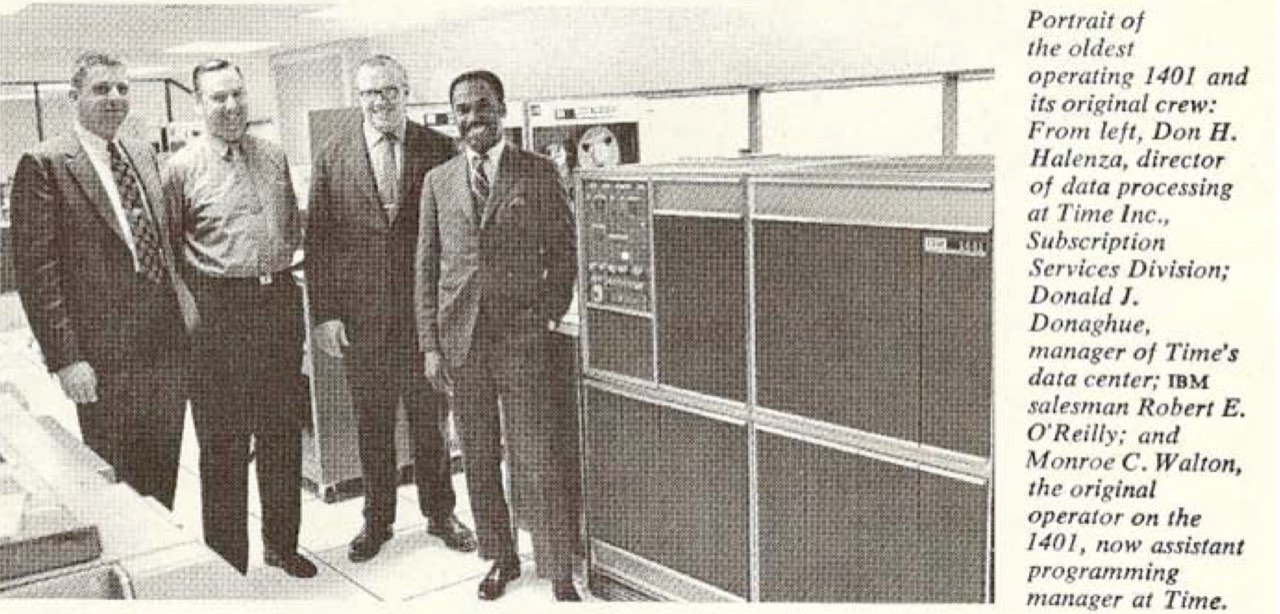 (Picture from above URL)
(Picture from above URL)
In all the 1401s I’ve seen/experienced, the band between the cubes is wider:
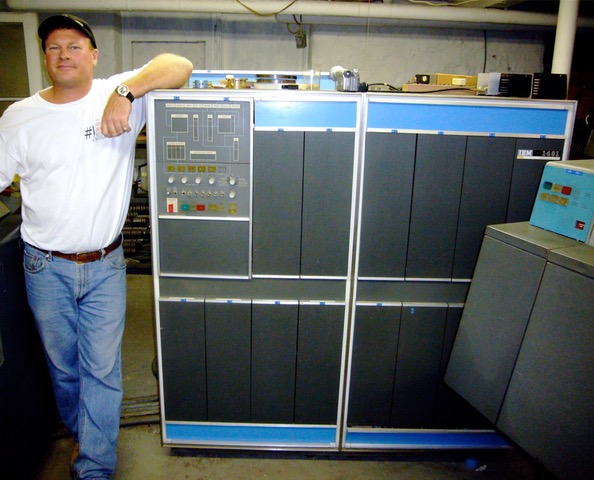
In the photo System A Test Unit, I can see now that it’s also narrower:
https://ibm-1401.info/Pics3/JudMcCarthy_1401SysATestUnit_1959.jpg
Do you know why the bad was made wider?
According to Chuck Branscomb, Time-Life received the very first production 1401:
https://ibm-1401.info/Branscomb-Main-1401-story.html
Initial Shipment: When we announced in October, 1959 we committed for shipment to occur in September of 1960. This time frame between announcement and shipment was not unusual in those days. We didn’t, however, really anticipate that the initial shipment would occur at 11:30 p.m. on September 30th, 1960. Of course I was on the manufacturing floor as the system was buttoned up, and moved to shipment. This system went to Time-Life in Chicago, as I recall, for the printing of labels for magazines.
...
|
from William Green February 3,2024
Re: Reference for Time-Life's 1960 transition from punched cards to magnetic tape
|
Robert,
I hadn't noticed the narrow middle band of the 1401 in the publicity photo that's on
display here but a few years ago an elderly visitor pointed out to me that difference
with our 1401. He explained the design had been changed due to mechanical aspects
of the cabling going to the gates. The cables were getting damaged when the gates
were opened and closed. Providing a wider space reduced stress on the cables.
Bill
|
|
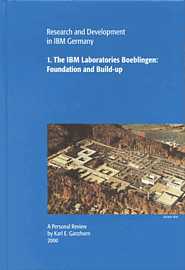
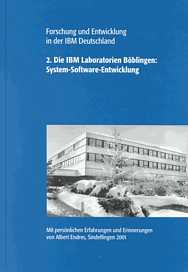
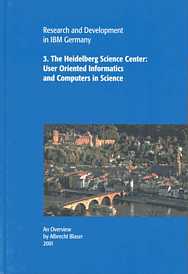
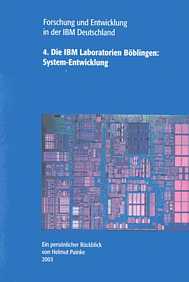
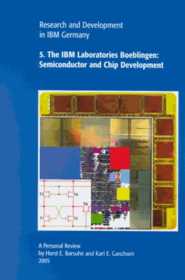
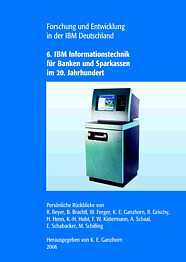
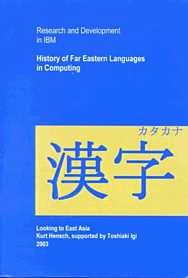
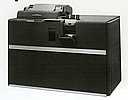

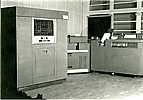
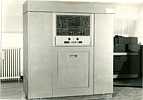
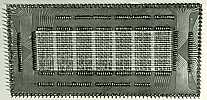
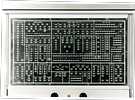

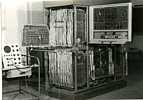
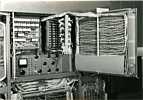
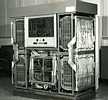
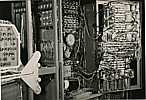
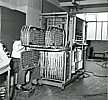

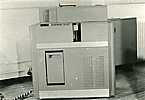
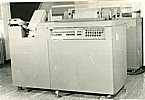
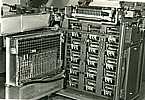
 (Picture from above URL)
(Picture from above URL)

